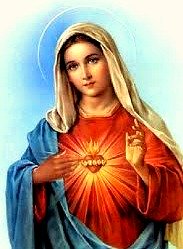Our Lady of Consolation

October 23: Our Lady of Consolation, near Honfleur, France
The Abbot Orsini wrote: “Our Lady of Consolation, near Honfleur. This chapel is much frequented; two children have been raised to life there, in memory of which their figures are there in silver.”
Also known as Our Lady of Grace, or Notre-Dame-de-Grace, the first thing that can be seen among the trees upon the height is a large crucifix that seems to bless the sea, although the Chapelle Notre-Dame-de-Grace is still invisible, hidden under the old trees that surround it. The present chapel is a small one located a short distance from that cross, and the tall trees and lawns that surround the church are in stark contrast to the church’s humble dimensions.
Once inside, everything is modest but neat. There is a low arch, and passing beneath it the view from the windows inside is obscured by the thick foliage of the surrounding trees. On the Gospel side is the statue of the Blessed Virgin on a short pillar. A fabric canopy frames the statue which depicts the Mother of God holding her Divine Child.
At the feet of Our Lady are placed small anchors and hearts of silver gilt that shine on the dais, and we see a small amount of flowers that are the humble obeisance’s of children and the poor. There are votive offerings hundreds of years old, and paintings of ships battered by storms, or broken upon the rocks, beneath which are brief accounts of the perils and the salvation sent after prayer to Notre-Dame-de Grace. Crutches lean against the wall as trophies demonstrating the victorious prayers of the healed cripples who now walk, and burning candles are constantly renewed beneath the holy image, exhibiting the persevering ardor of the faithful. It is a collective testimony of piety and edification from the servants of Mary.
Our Lady of Consolation
The origin of the pilgrimage to Notre-Dame de Grace goes back to the eleventh century. According to tradition, in the year 1034, Robert the Magnificent, Duke of Normandy, was sailing to England. He was suddenly assailed by a violent storm, and at the height of the danger he promised to build three chapels and devoted to the Blessed Virgin if he returned safely to his lands. The storm ended at once, and the prince immediately returned home to take care of his vow. He built one of the chapels promised near his castle, and dedicated it to Our Lady of Mercy. Another he built near Caen, which he called Notre-Dame de la Deliverance, and the third he built on the plateau overlooking Honfleur, which was named Notre Dame de Grace.
This chapel near Honfleur soon became a busy place of pilgrimage. There is an authentic document at the church from King Louis XI dated January 28, 1478, and letters showing that the chapel was endowed with a certain tract of land containing a house, a barn, etc.
The chapel partially collapsed, and the sea swallowed part of the cliff near the church during a violent earthquake that occurred on September 29, 1538. Only a section of one wall, the altar, and the statue of the Virgin Mary remained standing, but such was the devotion of the people to this special place that many pilgrims continued to come and pray kneeling amid the debris. Unfortunately the landslides did not cease, so finally, in 1602, the last vestiges of the sanctuary were removed to prevent the faithful from exposing their lives to the unremitting danger.
The faithful regretted the loss of their chapel, and one of them, Mr. Gonnyer, undertook to raise a new one. He dug the foundations one hundred paces from the old church to the south-west, but he was forced to stop at that point for lack of money. Offerings from the inhabitants of Honfleur did the rest, and in 1613 the chapel was raised, but she felt the poverty that prevailed in France at that time. It was a small building three times as long as it was wide; thatched, isolated among the heather, and looked more like a barn than a chapel.
The Capuchins took possession on March 16, 1621, and they planted a large wooden cross amid the ruins of the old chapel. They eventually replaced it with a stone cross that they placed closer to the chapel than the old one had been.
In the Middle Ages people understood that the Church provided for the moral and physical welfare of the people as well as the state. They knew that the apostolate of the monastic orders was necessary to form and maintain the ties of charity between the rich and poor, adjust the opulent life of one to soften the sufferings of others, and to communicate to all, through preaching and by example, the secret of living and dying well.
When the Revolution broke out, there was wide-spread desecration in the whole of France, and all religious communities were dissolved. In vain the faithful recipients of so many graces endeavored to protect their sanctuary and the religious who served there. At one time it was hoped Honfleur could keep the Capuchins, and so a petition was drafted for that purpose in 1790.
“Through the removal of religious communities,” said the petitioners, “we fear being deprived of the significant relief that we receive from the Capuchins. These men are religious at all times, labor for the good of the city and the neighboring country, and through the uprightness of their intentions and the justice of their actions they have earned public esteem and confidence. They have a small chapel, located on the coast under the invocation of the Blessed Virgin, which is held in great reverence throughout the country, and we urge its conservation.”
The petition was sent to the National Assembly, who refused it. The chapel was plundered and converted into a tavern. The old statue was destroyed, and sadly “those who were but lately to pray and ask for graces forgot themselves to commit orgies in a place where everything, even the walls, reproached them for their apostasy.”
That was so long ago, and now the tides of commercial prosperity have come to caress the people and promote the development of the city and the port of La Havre. Hanfleur possesses all the signs of a prosperous city that is increasing in wealth and population, regardless of the attendant demoralization and miseries of every kind that accompany the seeming prosperity. La Havre is the seat of business where speculators contest in the commercial sphere where they work without ceasing to earn their fortune and contribute to each other’s ruin. Without the aid of the Blessed Virgin, there was no longer any hope for relief.
Still, it was here, at this remote chapel about 5 kilometers from Honfleur, that Marie-Francoise-Therese Martin came with her father and sister Celine in July of the year 1887 to pray to Notre-Dame-de Grace that she might be able to enter Carmel. That woman is better known today as Saint Therese of the Child Jesus and the Holy Face, or simply Therese of Lisieux, the “Little Flower.”
Our Lady of Consolation, roman-catholic-saints.com, James Fitzhenry, Marian Calendar
Have A Great Story About This Topic?
Do you have a great story? Have You Visited This Shrine? Share it!
Return to Marian Calendar October
Return to Roman Catholic Saints Home Page from Our Lady of Consolation
Now Available!!
Pelayo's resistance initiated the nearly 800-year-long Reconquista to take back his country from the ruthless invader who had conquered his homeland and sought to erase his culture and his faith. His actions would lay the foundations of a Kingdom for Christ that would eventually reach around the world and spread the Catholic faith to millions of souls. Read more...
Please help us continue to bring high quality books to our readers at the lowest possible price! Click the link below! Thank you!
Now Available!
Catholic Vitality Publications presents . . .Brand new by
James Fitzhenry
Now in paperback!
Battles - Honor - Miracles! This
book is filled with amazing stories of little-known Catholic heroes presenting
spectacles of bravery and valor never exceeded in all the annals of history. read more. . .
Now Available for $24.95
Also available:
Catholic Vitality Publications
Roman Catholic books currently published by Catholic Vitality Publications:
El Cid, God's Own Champion
-the amazing true story of the life of Rodrigo Diaz, El Cid!
Available for only $22.95
St. Fernando III
A Kingdom for Christ
- King St. Fernando III, born 100
years to the month after the death of
the Cid. His life was filled with miracles
and many conquests!
Available now for $26.95
Discounts available for bulk
orders and for bookstore
retail sales! Just contact us




